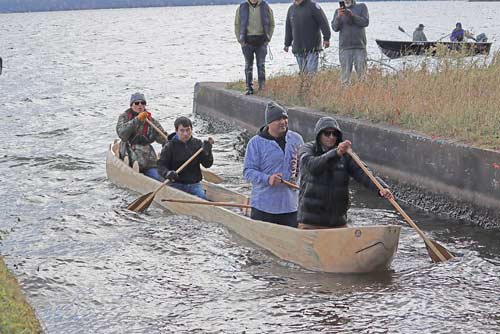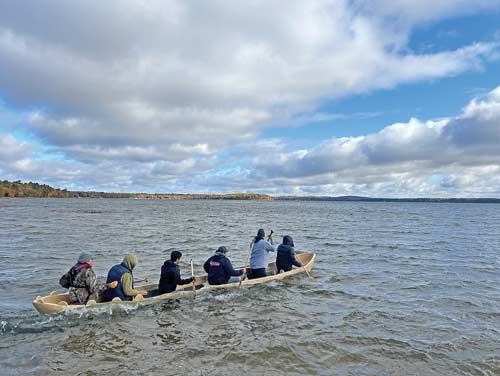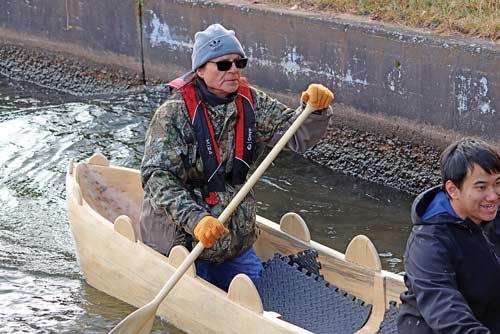October 29, 2024 at 5:55 a.m.
‘The Mikinaak’ sets sail in Lac du Flambeau, wrapping two-year school project
Almost all the students at Lac du Flambeau Public School played a role over the last two years in helping Ojibwe language teacher Wayne Valliere build a dugout canoe.
The project reached its peak when students gathered at the Thorofare and Fence Lake boat launch area on Tuesday, Oct. 15, to see the boat set sail.
“The spirits of our ancestors carried us all the way through that chain. It was one of the most magnificent things I’ve
ever done in my life. I could feel what it was like 500 years ago.”
Wayne Valliere
Lac du Flambeau
Public School
Valliere is known far and wide for his birch bark canoes, but this was the first dugout canoe he said he’s built. The difference between the two, he indicated, is birch bark canoes are smaller and easier to traverse whereas dugout canoes are larger and can carry more people.
The project was funded with the help of the Luce Indigenous Knowledge Fellowship, which is a program between First Nations and the Henry Luce Foundation. According to the First Nations’s website, the fellowship, which began in 2019, is “to honor and support a select cohort of fellows as they work to further Indigenous knowledge creation, dissemination and change in Indigenous communities.”
Valliere explained how the process of crafting the canoe unfolded the last two years.
“The project took two years and the two years was because the research we did on how our paleo-ancestors actually took care of the log and understanding that it had to be dried for a series of months, and cut down in the spring so it could dry for a whole summer with the bark on it so the pitch oozes out the ends,” he said. “Then at the end of the summer, the bark was taken off, the tree was put up on stilts to dry into winter where it was covered until the next spring. The next spring, it was uncovered and debarked and then we started the carving process that fall (and into) last summer. So it’s been amazing.”
 The group paddles the canoe down the canal. Front to back, Leon Boycee Valliere, Lawrence Mann, Derek Phi and Wayne Valliere.
The group paddles the canoe down the canal. Front to back, Leon Boycee Valliere, Lawrence Mann, Derek Phi and Wayne Valliere.(Photo by Kate Reichl/
Lakeland Times)
Students from second to eighth grade all helped create the canoe each day and Valliere noted students in grades below that came to see the canoe process “all time.”
Each canoe is unique in its own way.
“Because every tree in the forest is unique,” Valliere said. “Not one is exactly like the other.”
This particular dugout canoe came from a vision Valliere had.
That vision, he described, was of a snapping turtle floating on the water in the middle of a lake.
“In my dream, I heard laughter and it wasn’t a giant snapper turtle, it was actually a wooden canoe,” Valliere said. “And when the people were in the middle of it, it made the shell of the canoe and then the head stuck out of the water and you could see the spikes of the snapper’s tail. So that’s why that (detail) was added to this canoe and we went with that design, naming this canoe ‘The Mikinaak,’ which means the snapping turtle.”
He also mentioned there’s Anishinaabe legends told by elders which include tales of the “Great Snapping Turtle Island,” which was an island built on the back of a snapping turtle.
 The group paddles on Fence Lake. Back to front, Wayne Valliere, Michael Cisneros, Derek Phi, Rob Valliere, Lawrence Mann and Leon Boycee Valliere.
The group paddles on Fence Lake. Back to front, Wayne Valliere, Michael Cisneros, Derek Phi, Rob Valliere, Lawrence Mann and Leon Boycee Valliere.
(Photo by Kate Reichl/Lakeland Times)Using methods from paleo-ancestors, Valliere said “an incredible amount of data” was gathered.
He said they tried to get the canoe as close as possible to what an original dugout canoe was like.
Valliere mentioned friends from the University of Wisconsin-Madison and Northwestern University who helped with that effort.
“Some of the stuff we’re doing might change the course of evolution of man,” he said. “Because some of the data they have now isn’t lining up to what we actually produced. And science … it’s constantly changing, that’s what’s great about it.”
Valliere indicated making the canoe was an instance where art and science intersected.
To practice, he said, students were exposed to using tools like fire and clam shells, among others, similar to the tools paleo-ancestors used. Modern tools were used as well, though, Valliere said, which also was valuable learning for the students.
“It’s still a native canoe, just like the Indians 500 years ago,” he said. “Why? Because native hands built it and native ingenuity.”
 Wayne Valliere paddles the dugout canoe.
Wayne Valliere paddles the dugout canoe.(Photo by Kate Reichl/Lakeland Times)
The canoe, Valliere said, was tested the day before and the conditions were very calm. That worked out well, because he said dugout canoes are made for calmer waters.
“Those old canoes weren’t made for huge waves,” Valliere said. “So the second day, when we went to launch it, Fence Lake was choppy. So we had to get it in the channel. Once we got it into the channel with the calmer water, we paddled the canoe from Fence Lake across Crawling Stone Lake into Long Interlocken (Lake). We crossed Long Interlaken (and) we went into Flambeau Lake. We came through Flambeau Lake into Pokegama (Lake) (and) crossed Pokegama to the casino, where we pulled the canoe up.”
Each lake, he said, was “quite rough.”
“So we had to be very careful in maneuvering that canoe,” Valliere said. “Usually we can put eight to 10 people in it, (but) because of the choppy waves that day, we could only put three people in it. So, like my older brother said, our paleo-ancestors were showing us how difficult they had it back in those times when they had to go out ... in those types of waves to do certain things.”
Life wasn’t easy for his ancestors, he said, and because of that, Valliere indicated how important experiences like this are for Ojibwe culture.
“It was cold, it was choppy, but we persevered through it,” he said. “The spirits of our ancestors carried us all the way through that chain. It was one of the most magnificent things I’ve ever done in my life. I could feel what it was like 500 years ago.”
Valliere explained dugout canoes were made for bigger bodies of water.
“Our 18-lake chain in Lac du Flambeau, a perfect example,” he said. “Those canoes are used to transfer large amounts of cargo from a 20-mile point. You could take six trips with a birch bark canoe or you could take one trip with a dugout, which makes more sense. Time was everything back then. They went with the seasons.”
The dugout canoe will be displayed in the school now. It will likely serve as a reminder of all the work that was put into it for many students.
“Like I said, over 95 percent of our students touched that canoe and worked on it … and learned a lot about white pine trees and what used to stand in northern Wisconsin when that tree was a sapling,” Valliere said. “They understand that we could drink the water out of every lake in northern Wisconsin when that tree was a sapling. When that tree was a sapling, the air was 30-percent cleaner.”
Trevor Greene may be reached via email at [email protected].


Comments:
You must login to comment.